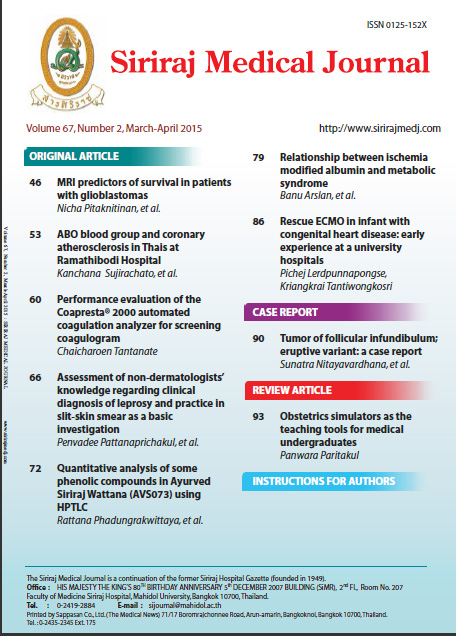Performance Evaluation of the Coapresta®2000 Automated Coagulation analyzer for Screening Coagulogram
Abstract
Objective: The Coapresta®2000 (CP) is an automated analyzer which can perform various coagulation assays. The author aimed to validate the CP performance for screening coagulogram testing, including APTT, PT, and fibrinogen assays, under our local situation such that the data could be applied to the laboratory in Thailand.
Methods: The real patients’ samples and control materials were used to evaluate the CP in terms of precision, reference range, comparability to the validated analyzer Sysmex® CS-2100i (CS), carryover, and turnaround time.
Results: The highest percentages of coefficient of variation of APTT, PT, and fibrinogen were 1.05, 3.92 and 2.53 for within run and 2.15, 2.71 and 6.53 for between run precision studies. The correlation coefficient of PT and fibrinogen between CP and CS were 0.99, while it was 0.77 for APTT. Considering warfarin dose adjustment, 6% of patients might require dose adjustment when using CP instead of CS. Carryover was not observed. The turnaround time of first specimen was less than 6 minutes for APTT and 3 minutes for PT and fibrinogen.
Conclusion: The performance of CP for screening coagulogram in terms of precision and carryover was acceptable. The turnaround time was short. The comparability between CP and CS was excellent for PT and fibrinogen, but was fair for APTT. The participation of external quality assurance scheme is needed to assess the accuracy.
Keywords: Coapresta®2000, automated analyzer, performance evaluation, screening coagulogram
Downloads
Published
How to Cite
Issue
Section
License
Authors who publish with this journal agree to the following conditions:
Copyright Transfer
In submitting a manuscript, the authors acknowledge that the work will become the copyrighted property of Siriraj Medical Journal upon publication.
License
Articles are licensed under a Creative Commons Attribution-NonCommercial-NoDerivatives 4.0 International License (CC BY-NC-ND 4.0). This license allows for the sharing of the work for non-commercial purposes with proper attribution to the authors and the journal. However, it does not permit modifications or the creation of derivative works.
Sharing and Access
Authors are encouraged to share their article on their personal or institutional websites and through other non-commercial platforms. Doing so can increase readership and citations.










